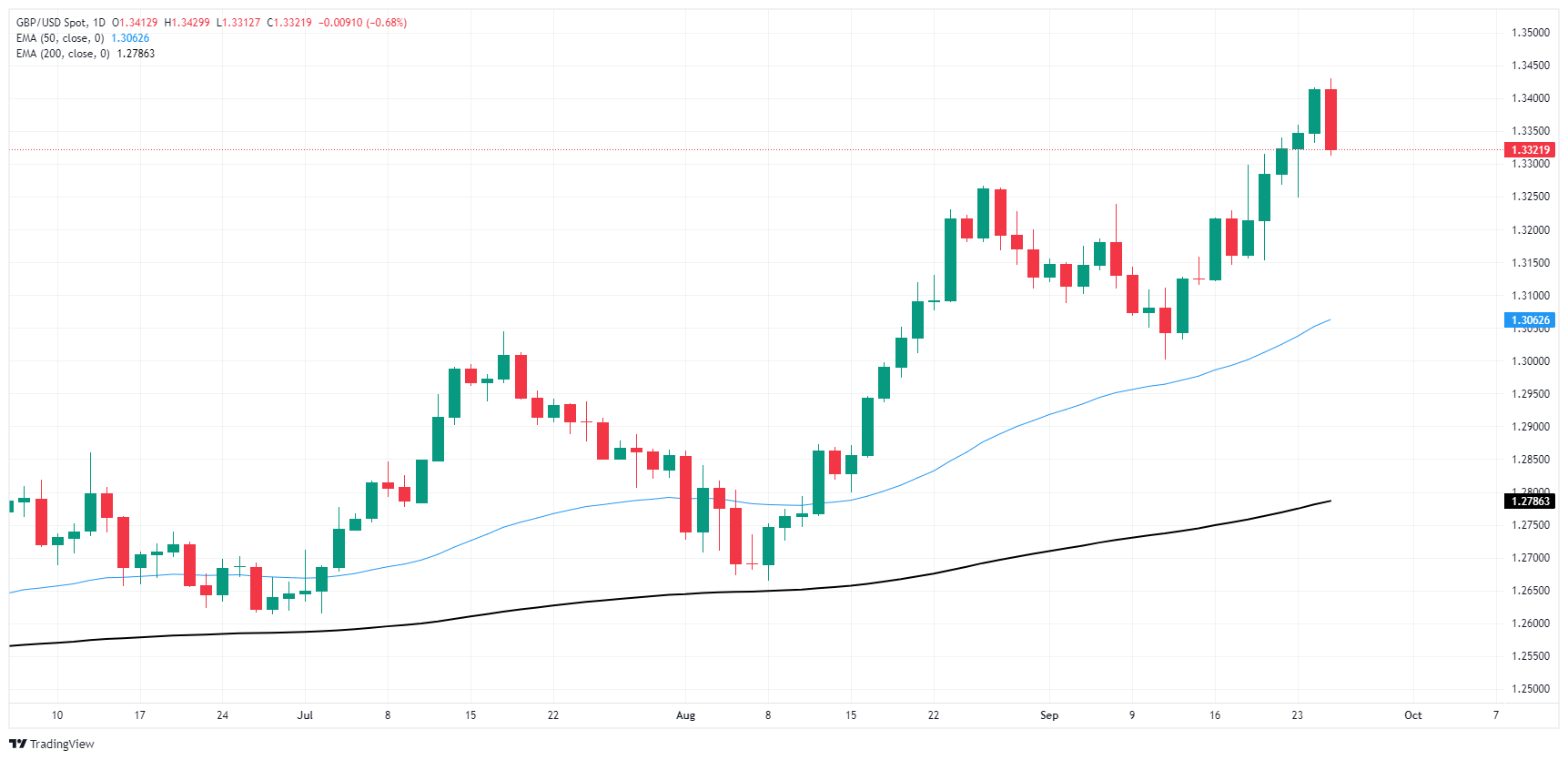- Analytics
- News and Tools
- Market News
- GBP/USD sheds 1.34 amid Greenback rebound
GBP/USD sheds 1.34 amid Greenback rebound
- GBP/USD turned bearish and dropped back below 1.34 on Wednesday.
- Markets pared back their recent tilt into a Pound Sterling bull run.
- The US Dollar recovered ground as investors weigh the state of the US economy.
GBP/USD struck an abnormally nearish tone on Wednesday, plunging back below the 1.3400 handle amid a broad-market pullback from full-bore risk appetite. The Pound Sterling paused its recent one-sided trend into the high side, while the Greenback pared recent losses.
The Pound Sterling will be entirely absent from the economic calendar data docket for the remainder of the week, leaving GBP/USD traders to grapple with Friday’s upcoming US inflation print.
US consumer confidence indicators fell this week as the average US consumer doesn’t share in the stock market’s exuberance over Fed rate cuts, with key confidence readings falling to their lowest levels in three years and consumer inflation expectations for the next 12 months ticking higher. This Friday will see a fresh update to US Personal Consumption Expenditure (PCE) inflation figures.
New home sales also fell in August, declining 4.7% to 716K from the previous month’s revised 751K. Meanwhile, investors will see another print of US Gross Domestic Product (GDP) growth for the second quarter, expected to hold steady at 3.0% on an annualized basis. Thursday will also bring a slew of speeches and public appearances from several Fed officials, including Fed Chair Jerome Powell.
Economic Indicator
New Home Sales Change (MoM)
The number of New Home sales released by the US Census Bureau is an important measure of housing market conditions. House buyers spend money on furnishing and financing their homes so as a result the demand for goods, services and the employees is stimulated. Generally, a high reading is seen as bullish for the USD, whereas a low reading is seen as bearish.
Read more.Last release: Wed Sep 25, 2024 14:00
Frequency: Monthly
Actual: -4.7%
Consensus: -
Previous: 10.6%
Source: US Census Bureau
GBP/USD price forecast
Wednesday’s bearish reversal has pulled Cable back below 1.3400, and price action is poised for a continuation into the low side. Particularly brassve short sellers will be targeting the 50-day Exponential Moving Average (EMA) all the way down at 1.3062. GBP/USD bidders will be looking to recover ground back into 30-month highs set this week at 1.3430.
GBP/USD daily chart
Pound Sterling FAQs
The Pound Sterling (GBP) is the oldest currency in the world (886 AD) and the official currency of the United Kingdom. It is the fourth most traded unit for foreign exchange (FX) in the world, accounting for 12% of all transactions, averaging $630 billion a day, according to 2022 data. Its key trading pairs are GBP/USD, aka ‘Cable’, which accounts for 11% of FX, GBP/JPY, or the ‘Dragon’ as it is known by traders (3%), and EUR/GBP (2%). The Pound Sterling is issued by the Bank of England (BoE).
The single most important factor influencing the value of the Pound Sterling is monetary policy decided by the Bank of England. The BoE bases its decisions on whether it has achieved its primary goal of “price stability” – a steady inflation rate of around 2%. Its primary tool for achieving this is the adjustment of interest rates. When inflation is too high, the BoE will try to rein it in by raising interest rates, making it more expensive for people and businesses to access credit. This is generally positive for GBP, as higher interest rates make the UK a more attractive place for global investors to park their money. When inflation falls too low it is a sign economic growth is slowing. In this scenario, the BoE will consider lowering interest rates to cheapen credit so businesses will borrow more to invest in growth-generating projects.
Data releases gauge the health of the economy and can impact the value of the Pound Sterling. Indicators such as GDP, Manufacturing and Services PMIs, and employment can all influence the direction of the GBP. A strong economy is good for Sterling. Not only does it attract more foreign investment but it may encourage the BoE to put up interest rates, which will directly strengthen GBP. Otherwise, if economic data is weak, the Pound Sterling is likely to fall.
Another significant data release for the Pound Sterling is the Trade Balance. This indicator measures the difference between what a country earns from its exports and what it spends on imports over a given period. If a country produces highly sought-after exports, its currency will benefit purely from the extra demand created from foreign buyers seeking to purchase these goods. Therefore, a positive net Trade Balance strengthens a currency and vice versa for a negative balance.
© 2000-2024. All rights reserved.
This site is managed by Teletrade D.J. LLC 2351 LLC 2022 (Euro House, Richmond Hill Road, Kingstown, VC0100, St. Vincent and the Grenadines).
The information on this website is for informational purposes only and does not constitute any investment advice.
The company does not serve or provide services to customers who are residents of the US, Canada, Iran, The Democratic People's Republic of Korea, Yemen and FATF blacklisted countries.
Making transactions on financial markets with marginal financial instruments opens up wide possibilities and allows investors who are willing to take risks to earn high profits, carrying a potentially high risk of losses at the same time. Therefore you should responsibly approach the issue of choosing the appropriate investment strategy, taking the available resources into account, before starting trading.
Use of the information: full or partial use of materials from this website must always be referenced to TeleTrade as the source of information. Use of the materials on the Internet must be accompanied by a hyperlink to teletrade.org. Automatic import of materials and information from this website is prohibited.
Please contact our PR department if you have any questions or need assistance at pr@teletrade.global.















